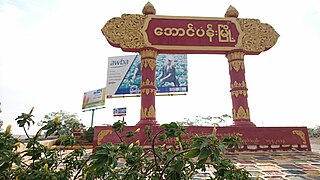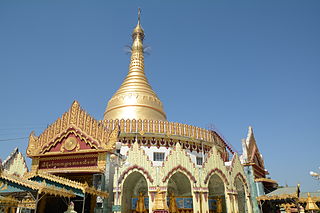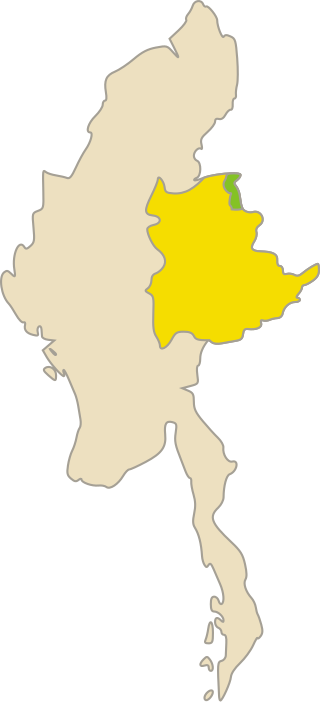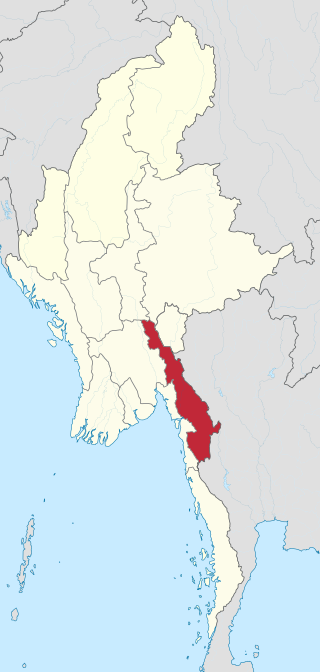
Shan State is a state of Myanmar. Shan State borders China (Yunnan) to the north, Laos to the east, and Thailand to the south, and five administrative divisions of Myanmar in the west. The largest of the 14 administrative divisions by land area, Shan State covers 155,800 km2, almost a quarter of the total area of Myanmar. The state gets its name from Burmese name for the Tai peoples: "Shan people". The Tai (Shan) constitute the majority among several ethnic groups that inhabit the area. Shanland is largely rural, with only three cities of significant size: Lashio, Kengtung, and the capital, Taunggyi. Taunggyi is 150.7 km northeast of the nation's capital Naypyitaw.

Myanmar is divided into 21 administrative divisions, which include seven regions, seven states, one union territory, one self-administered division, and five self-administered zones.

The Karen, also known as the Kayin, Kariang or Kawthoolese, are an ethnolinguistic group of Sino-Tibetan language-speaking peoples. The group as a whole is heterogeneous and disparate as many Karen ethnic groups do not associate or identify with each other culturally or linguistically. These Karen groups reside primarily in Kayin State, southern and southeastern Myanmar. The Karen account for around seven percent of the Burmese population. Many Karen have migrated to Thailand, having settled mostly on the Myanmar–Thailand border. A few Karen have settled in the Andaman and Nicobar Islands, India, and other Southeast Asian and East Asian countries.
In Myanmar, terrorism is defined by the country's counter-terrorism law and its subsections, which is interpreted by the Anti-Terrorism Central Committee and enforced by the government of Myanmar. Two groups are currently listed as terrorist organisations in accordance with Myanmar's counter-terrorism law; the Arakan Rohingya Salvation Army (ARSA), which was added on 25 August 2017, and the Arakan Army, which was added on 18 January 2019. The SPDC military government called the Vigorous Burmese Student Warriors (VBSW) "terrorists" after their role in the 1999 Myanmar Embassy siege, but the group was never legally declared as such.

Insurgencies have been ongoing in Myanmar since 1948, the year the country, then known as Burma, gained independence from the United Kingdom. The conflict has largely been ethnic-based, with several ethnic armed groups fighting Myanmar's armed forces, the Tatmadaw, for self-determination. Despite numerous ceasefires and the creation of autonomous self-administered zones in 2008, many armed groups continue to call for independence, increased autonomy, or the federalisation of the country. The conflict is the world's longest ongoing civil war, having spanned more than seven decades.

Aungban is a major trading town in the southern Shan State of Myanmar that supplies agricultural yield to the rest of the country. It is located in Kalaw Township which is part of Taunggyi District. It lies on the Thazi-Kyaingtong road at an elevation of 4,219 feet (1,286 m) above sea level.

Kaba Aye Pagoda, formally Thiri Mingala Gaba Aye Zedidaw, သီရိမင်္ဂလာကမ္ဘာအေးစေတီတော်), is a Buddhist pagoda located on Kaba Aye Road, Mayangon Township, Yangon, Myanmar. The pagoda was built in 1952 by U Nu in preparation for the Sixth Buddhist Council that he held from 1954 to 1956. The pagoda measures 111 feet (34 m) high and is also 111 feet (34 m) around the base. The pagoda is located approximately 11 km north of Yangon, a little past the Inya Lake Hotel. The Maha Pasana Guha was built simultaneously with the Kaba Aye Pagoda and is located in the same complex. The cave is a replica of the Satta Panni cave, located in India, where the First Buddhist Synod was convened. The six entrances of The Maha Pasana Cave symbolize the Sixth Great Synod. The cave is 455 feet (139 m) long and 370 feet (110 m) wide. Inside, the assembly hall is 220 feet (67 m) long and 140 feet (43 m) wide.
Pyay Bagaya Intersection is a commercial market square located in Yangon, Burma. That is a most busiest district place in Yangon after Sule Pagoda Roundabout.
The October 2013 Myanmar bombings were a string of unexplained bombings that killed three people and injured 10 others from 11 to 17 October 2013 in different parts of Myanmar (Burma). There is no strong evidence to blame a particular group, but these attacks were likely connected.
The April 2010 Yangon Thingyan bombings were bomb blasts that had killed 10 people and injured 178 on 15 April 2010, in Yangon, Myanmar (Burma) during the Thingyan Water Festival.

The 2015 Kokang offensive was a series of military operations launched by the Myanmar Army in 2015 in Kokang in northern Shan State, Myanmar (Burma). Several clashes between the Myanmar Army and Myanmar National Democratic Alliance Army had taken place from February to May 2015.

Kayin State, formerly known as Karen State, is a state of Myanmar. The capital city is Hpa-An, also spelled Pa-An.
The 2018 Lashio bombing was a bomb blast in the town of Lashio, in northern Shan State, Myanmar, that killed two employees of Yoma Bank and injured 22 others.

The timeline of the 2021 Myanmar Revolution chronicles the 2021 Myanmar protests, known locally as the Spring Revolution, that began in early 2021 in opposition to the coup d'état on 1 February, staged by Min Aung Hlaing, the commander-in-chief of the country's armed forces, the Tatmadaw.

The People's Defence Force is the armed wing of the National Unity Government in Myanmar. The armed wing was formed by the NUG from youths and pro-democracy activists on 5 May 2021 in response to the coup d'état that occurred on 1 February 2021 that put the military junta and their armed wing the Tatmadaw in power. The military junta designated it as a terrorist organisation on 8 May 2021. In October 2021, NUG's Ministry of Defence announced that it had formed a central committee to coordinate military operations across the country.

The Myanmar civil war, also called the Burmese Spring Revolution, Burmese civil war or People's Defensive War, is an ongoing civil war following Myanmar's long-running insurgencies, which escalated significantly in response to the 2021 military coup d'état and the subsequent violent crackdown on anti-coup protests. The NUG and major ethnic armed organisations repudiated the 2008 Constitution and called instead for a democratic federal state. Besides engaging the rebels, the junta also contends with anti-junta forces in areas under its control.
Events in the year 2022 in Myanmar.
The following is a timeline of major events during the Myanmar civil war (2021–present), following the 2021 military coup d'état and protests. It was also a renewed intensity in existing internal conflict in Myanmar.
This is the list of important events happened in Myanmar in 2023.










